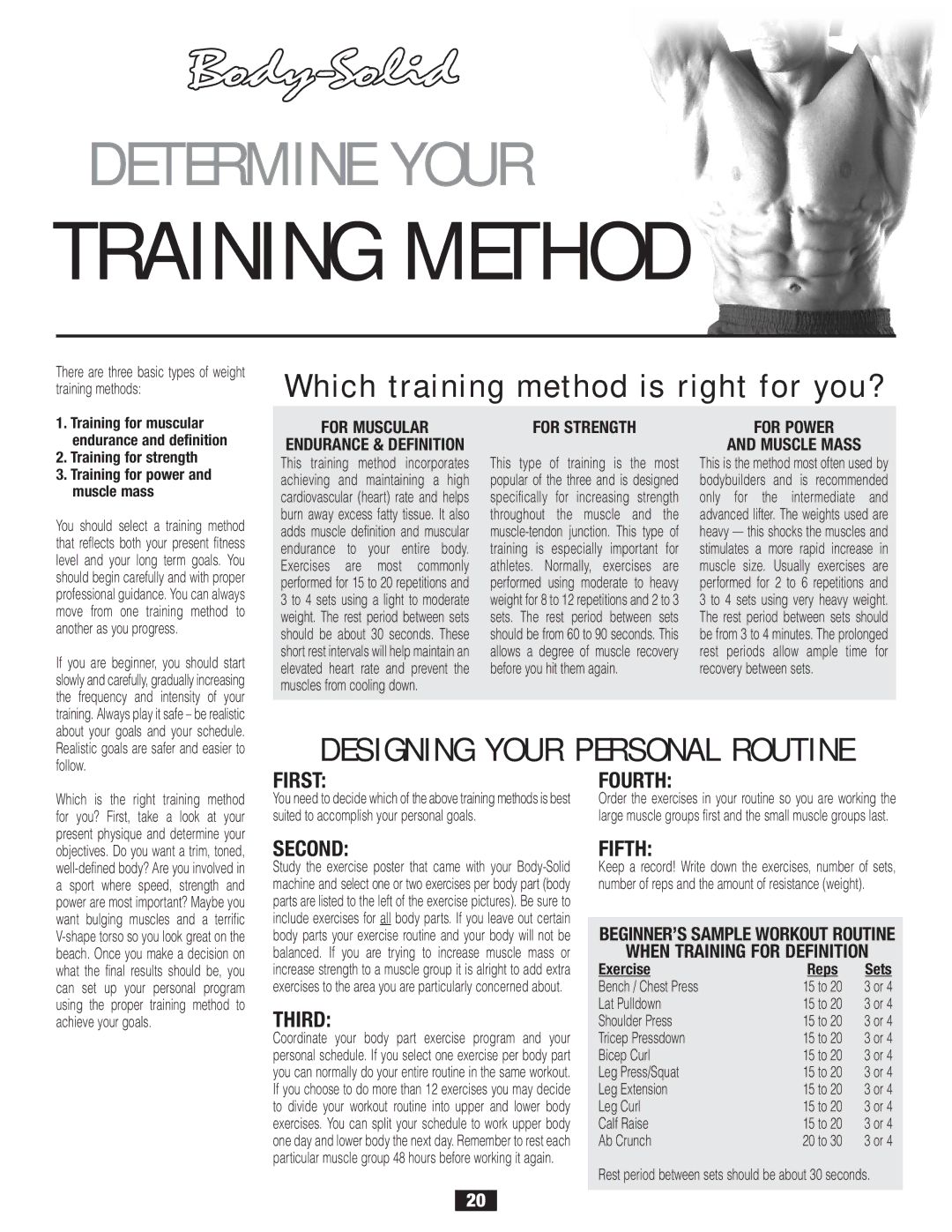
DETERMINE YOUR
TRAINING METHOD
There are three basic types of weight training methods:
1. Training for muscular |
endurance and definition |
Which training method is right for you?
FOR MUSCULAR | FOR STRENGTH | FOR POWER |
ENDURANCE & DEFINITION |
| AND MUSCLE MASS |
2. | Training for strength |
3. | Training for power and |
| muscle mass |
You should select a training method that reflects both your present fitness level and your long term goals. You should begin carefully and with proper professional guidance. You can always move from one training method to another as you progress.
If you are beginner, you should start slowly and carefully, gradually increasing the frequency and intensity of your training. Always play it safe – be realistic about your goals and your schedule.
This training method incorporates achieving and maintaining a high cardiovascular (heart) rate and helps burn away excess fatty tissue. It also adds muscle definition and muscular endurance to your entire body. Exercises are most commonly performed for 15 to 20 repetitions and 3 to 4 sets using a light to moderate weight. The rest period between sets should be about 30 seconds. These short rest intervals will help maintain an elevated heart rate and prevent the muscles from cooling down.
This type of training is the most popular of the three and is designed specifically for increasing strength throughout the muscle and the
This is the method most often used by bodybuilders and is recommended only for the intermediate and advanced lifter. The weights used are heavy — this shocks the muscles and stimulates a more rapid increase in muscle size. Usually exercises are performed for 2 to 6 repetitions and 3 to 4 sets using very heavy weight. The rest period between sets should be from 3 to 4 minutes. The prolonged rest periods allow ample time for recovery between sets.
Realistic goals are safer and easier to follow.
Which is the right training method for you? First, take a look at your present physique and determine your
DESIGNING YOUR PERSONAL ROUTINE
FIRST: | FOURTH: |
You need to decide which of the above training methods is best | Order the exercises in your routine so you are working the |
suited to accomplish your personal goals. | large muscle groups first and the small muscle groups last. |
objectives. Do you want a trim, toned,
SECOND:
Study the exercise poster that came with your
THIRD:
Coordinate your body part exercise program and your personal schedule. If you select one exercise per body part you can normally do your entire routine in the same workout. If you choose to do more than 12 exercises you may decide to divide your workout routine into upper and lower body exercises. You can split your schedule to work upper body one day and lower body the next day. Remember to rest each particular muscle group 48 hours before working it again.
FIFTH:
Keep a record! Write down the exercises, number of sets, number of reps and the amount of resistance (weight).
BEGINNER’S SAMPLE WORKOUT ROUTINE
WHEN TRAINING FOR DEFINITION
Exercise | Reps | Sets |
Bench / Chest Press | 15 to 20 | 3 or 4 |
Lat Pulldown | 15 to 20 | 3 or 4 |
Shoulder Press | 15 to 20 | 3 or 4 |
Tricep Pressdown | 15 to 20 | 3 or 4 |
Bicep Curl | 15 to 20 | 3 or 4 |
Leg Press/Squat | 15 to 20 | 3 or 4 |
Leg Extension | 15 to 20 | 3 or 4 |
Leg Curl | 15 to 20 | 3 or 4 |
Calf Raise | 15 to 20 | 3 or 4 |
Ab Crunch | 20 to 30 | 3 or 4 |
Rest period between sets should be about 30 seconds.
20
